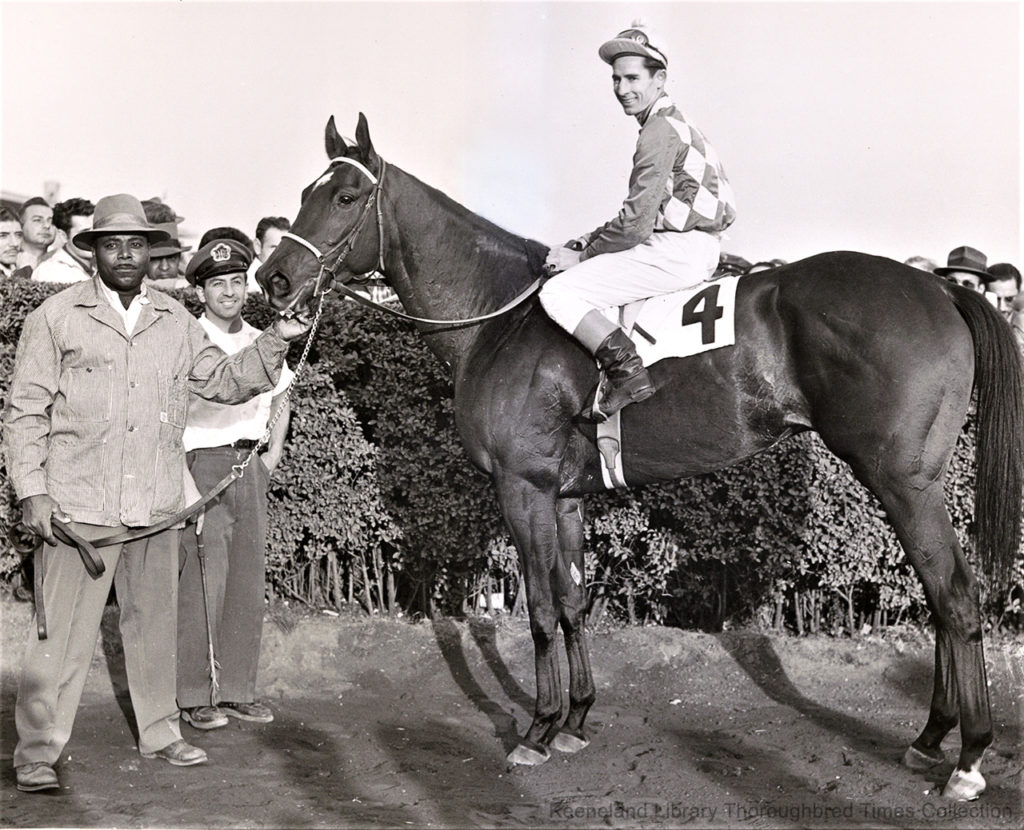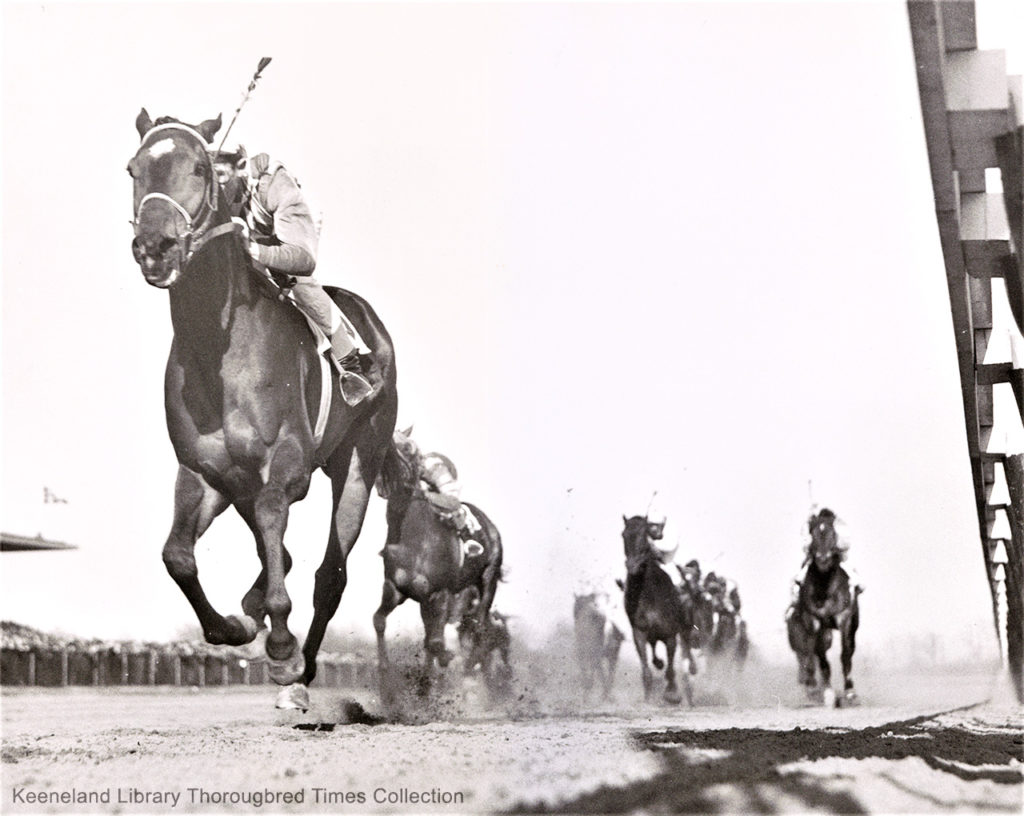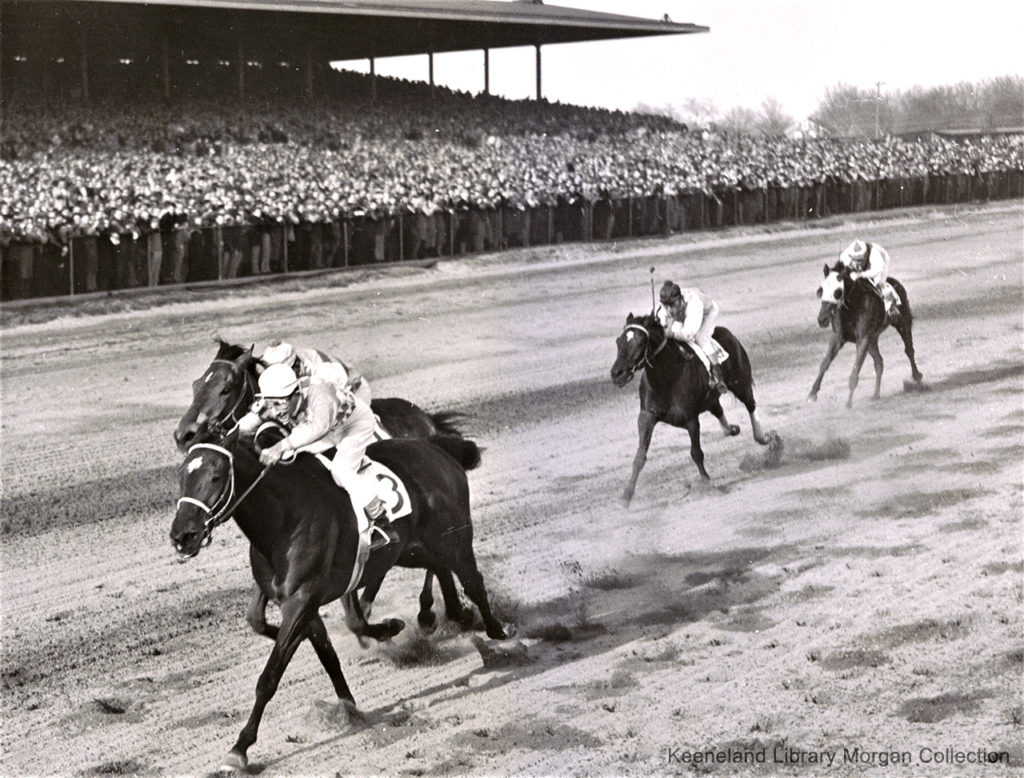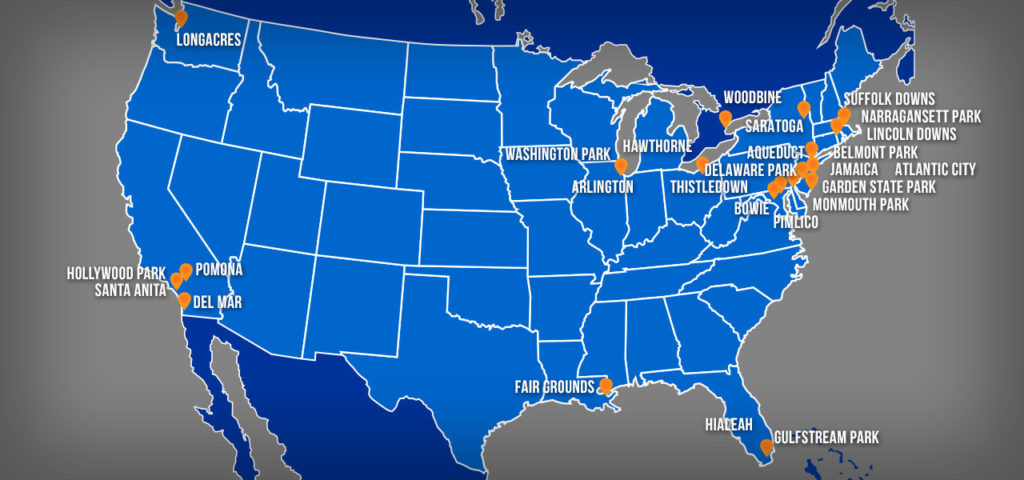
Like countless horses in history Find came along at perhaps the wrong time. Overshadowed at birth and for the first several years of his life by a superstar stablemate, he subsequently knocked heads with the best of generation after generation. He won enough smaller bouts to allow him repeated chances in the main event, but consistently proved the foil while often punching above his weight.
In this age of instant information and access he might have been a social media star. He was around so long and traveled so extensively for nearly a decade, to all four corners of the continental United States, that racing fans virtually everywhere had an opportunity to see him up close.
His innate talent might have imposed a ceiling on his achievements in any era, but few horses proved as durable or genuine. After 110 races of faithful service, after which he was the richest Thoroughbred ever born in his home state, his patrician owner-breeder gave him a worthy retirement which he took advantage of to the fullest.
This is the story of Find.

Three colts born in 1950 and raised at Alfred Gwynne Vanderbilt’s Sagamore Farm in Maryland that spring and summer would each leave their own imprint on the racetrack in that decade. And as was customary for a horse bred by Vanderbilt, their names were heavily influenced by those of their respective sire and dam.
The undisputed leader of the trio was Native Dancer, a son of Preakness winner Polynesian and the mare Geisha. The Kentucky-bred won all but one of 22 starts, that being the 1953 Kentucky Derby. Recognized as the sport’s first television star, due in part to his gray coat being discernable on the black and white sets of the time, Native Dancer was a champion at two and three and the consensus Horse of the Year at four.
Social Outcast, a son of Kentucky Derby winner Shut Out and the mare Pansy, picked up the baton after the retirement of Native Dancer, winning 11 stakes coast-to-coast in 1954 and 1955. Then there was Find, a son of Vanderbilt’s 1930s Hall of Famer Discovery and the Bimelech mare Stellar Role. Although Find arguably peaked at the ages of six and seven, he was a prominent player on the scene every year he raced in the 1950s.

Both Find and Social Outcast were gelded at age two, at the behest of Hall of Fame trainer Bill Winfrey.
“It was my decision to geld Find and Social Outcast, and I think the change benefited them both,” Winfrey would recall years later. “Find had his troubles at two – shin splints and bucked shins – so I took advantage of that lost season to geld him.
“Find had his growing pains, for sure, but when he came to the races at three, he was a sound horse.”
While Native Dancer was gearing up for the Kentucky Derby, Find’s career was just getting started. Entering perhaps the saltiest maiden race of the year, a 6-furlong event at Jamaica on April 6, Find finished third behind Level Lea and Joe Jones. Level Lea would go on to win that year’s Jockey Club Gold Cup, while Joe Jones captured 10 stakes during a protracted career of 175 races.
Find broke his maiden 10 days later and then won five of his following nine starts, all in overnight company. Having exhausted his allowance conditions, it was time for the bay to step up in class. The first race chosen was a rather unusual one at the time for such a high-class outfit: the Ohio Derby at Thistledown, run that year in October. Find was made the 7-2 favorite for the 1 1/8-mile race and won wire-to-wire by two lengths in 1:48, demolishing the previous track mark by 2 3/5 seconds.
While Native Dancer was easily best of the nation’s 3-year-olds, Find came on late to make his own mark on the division. After his Ohio Derby triumph, he captured the Grey Lag and Empire City handicaps, both at Jamaica. Although judged 12 pounds inferior to Native Dancer on the Daily Racing Form/Morning Telegraph Free Handicap, Find was rated third behind his stablemate and Level Lea.
Find the Older Years

Find remained unbeaten in stakes through his first start as a 4-year-old, a victory over 1952 Kentucky Derby winner Hill Gail in the 7-furlong San Carlos H. at Santa Anita. However, his campaign proved a rather uneven one.
Although he added two more stakes wins in New York and placed in races like the Massachusetts H. and Brooklyn H., Find wound up unplaced in eight of 15 stakes appearances. Some were slightly ambitious, such as a turf foray in the Arlington H. where he finished eighth to Stan, the champion grass horse that year.
In what was a harbinger for the rest of his career Find hit every major circuit of the era that season, stopping in Southern California, New York, New Jersey, New England, and Chicago. He would eventually notch 26 racetracks over which he made at least one stakes appearance, 27 if you count the old and new Aqueducts separately.

In 1955, with Native Dancer retired and Social Outcast among the leading older horses in the country, Find unfortunately sat on the sidelines.
“Strained a check ligament that year, and we have him the entire season off,” Winfrey recalled. “It was a fairly serious injury, but nothing that time wouldn’t heal. We sent him to the farm and forgot about him for a while.”
Find stayed in shape and, despite his gelded status, preferred the company of females.
“Whenever Find or [Social Outcast] would come back to the farm, I’d put them out to roam with a few barren mares,” said Sagamore manager Ralph Kercheval. “That kept the boys’ weight down a little even though they were geldings, because they would make a little fuss over the mares just the same.”
6-years-old and peak performance
Find’s stakes debut as a 6-year-old came in the prestigious 1 1/4-mile Widener H. at Hialeah. Witnessed by an all-time record crowd of 42,366, Find ran one of the best races of his career and one of the few that still survives on film.
The star of the show was reigning Horse of the Year Nashua, making his first start since October and spotting the field a minimum of six pounds. Perceived as being distance-limited at the time, Find (#2) was ostensibly used as a pacemaker for Social Outcast, but grudgingly gave in only in the final sixteenth racing along the rail. He crossed the wire fourth in a blanket finish won by Nashua over Social Outcast.
“I wouldn’t have sent Find to the lead so hard if I thought he would’ve lasted like that,”
Jockey Ted Atkinson told the connections.
The Widener was one of five meetings Find had with Nashua that season. He out-finished the Hall of Famer twice while receiving considerable weight, but didn’t win either race. In the Grey Lag in early May, Find gave Nashua all he could handle. Re-rallying to engage the star in upper stretch, Find just missing by a head after a prolonged stretch duel.
Find won three stakes that season: the New Orleans H. at Fair Grounds, the Excelsior H. at Jamaica, and the Narragansett Special in his penultimate start. He also proved a more consistent check-getter than he had two years earlier. Notable placings included the Brooklyn and Hawthorne Gold Cup behind Dedicate, co-Horse of the Year the following season; the Atlantic City H. behind champion older mare Blue Sparkler; and the United Nations H. to grass champion Career Boy.
Beginning with his third in the Brooklyn, Find won or placed in 20 consecutive stakes, a streak that lasted until his final start of 1957.
“Find was a champion to plungers who bet only on horses to show. They loved him – money in the bank,” Winfrey said. “Find was a durable old character, cut from tough fabric. Any horse that could finish in the money in 20 straight races had to be tough.”
1957
With the competition perceived as softer in Southern California, Vanderbilt and Winfrey decided an extended stay at Hollywood Park in the summer of 1957 might turn Find into a more consistent winner.
Their observation proved nearly spot on. Competing in seven stakes during the 55-day meet Find won four, ranging in distance from the 6-furlong Hollywood Premiere H. on opening day to the 1 5/8-mile Sunset H. on closing day. In between he captured the Inglewood and American handicaps.
In two of his three losses at the meet Find finished behind an up-and-coming 3-year-old named Round Table. Carrying equal weight on the scale in the Californian, Round Table beat Find by 4 1/2 lengths for second. In the Hollywood Gold Cup, Round Table beat Find by more than five lengths while conceding a pound on the scale to his older rival.
The Sunset would prove to be Find’s 13th and final career stakes win. Shipped back east he placed in four of his final five starts of the year, including thirds to Round Table in the United Nations and Hawthorne Gold Cup. He achieved a similar position in the Canadian Championship at Woodbine, a year before that race was switched to turf.
Slowing Down to Sagamore
Showing signs of slowing down after the winter and spring of 1958, when he placed in only two of five stakes attempts, Find joined Social Outcast in retirement at Sagamore. However, it didn’t last long.
“He had been campaigned pretty hard, but after a brief rest, he didn’t seem to be too happy on the farm,” Kercheval said. “I told Bill that, and we put him back in training.”
Again shipped west for the 1959 Hollywood meet, Find did well to finish second to the rising Indiana-bred star Hillsdale in both the American and Hollywood Gold Cup. However, two subsequent losses at Del Mar, where the quality was not on par with Santa Anita or Hollywood at the time, suggested the 9-year-old’s best days were truly behind him.
Despite some middling runs at the end of 1959, Find was back racing as a new decade dawned. For the longest time he’d been within shouting distance of the earning records for a gelding, set by Calumet Farm’s Hall of Famer Armed in the late 1940s.
“It crossed our minds to go for Armed’s record, but we weren’t going to run Find to death to do it,”
Winfrey
There were some creative placements, though. After struggling in Southern California throughout the summer of 1960, Find took off for the Pacific Northwest and was actually favored to pull off the Longacres Mile at the ripe age of 10. The veteran chalked up yet another third-place finish. Find’s next three starts were over the Los Angeles County Fair bullring at Pomona, later known as Fairplex Park, but he could only manage to be the show players’ friend on two of those occasions.
The quest of surpassing Armed’s record fell short in the summer of 1961.
After placing in two minor grass stakes, at Suffolk Downs and Delaware Park, time was finally called on Find’s lengthy career. His career mark was 110-22-27-27, his stakes record 76-13-16-22.
Almost $14,000 short of catching Armed’s record for a gelding, Find nonetheless bankrolled $803,615, a then-record for a Maryland-bred. That figure is equivalent to more than $7.4 million today.
When he wasn’t serving as a teaser, Find roamed the Sagamore grounds with old pal Social Outcast until the latter’s death in 1969 (Native Dancer died in 1967). Find lived another decade, sometimes leading a caravan of his barren and maiden female companions.
“The women all follow him,” said Sagamore employee Ellwood ‘Boo’ Boblits. “If I holler for him, he’ll come up over the hill with his ole lope, and all the girls will be right behind.”
Find was found dead of a heart attack, at age 29, by Boblits on Feb. 26, 1979. He rightfully rests beside his peers from the crop of 1950, and other Vanderbilt-owned greats, at Sagamore.
Sources
1953 American Race Horses
1956 American Race Horses
1957 American Race Horses
The Blood-Horse: Mar. 19, 1979
The Maryland Horse: March 1979
Thoroughbred Record: Mar. 7, 1979


